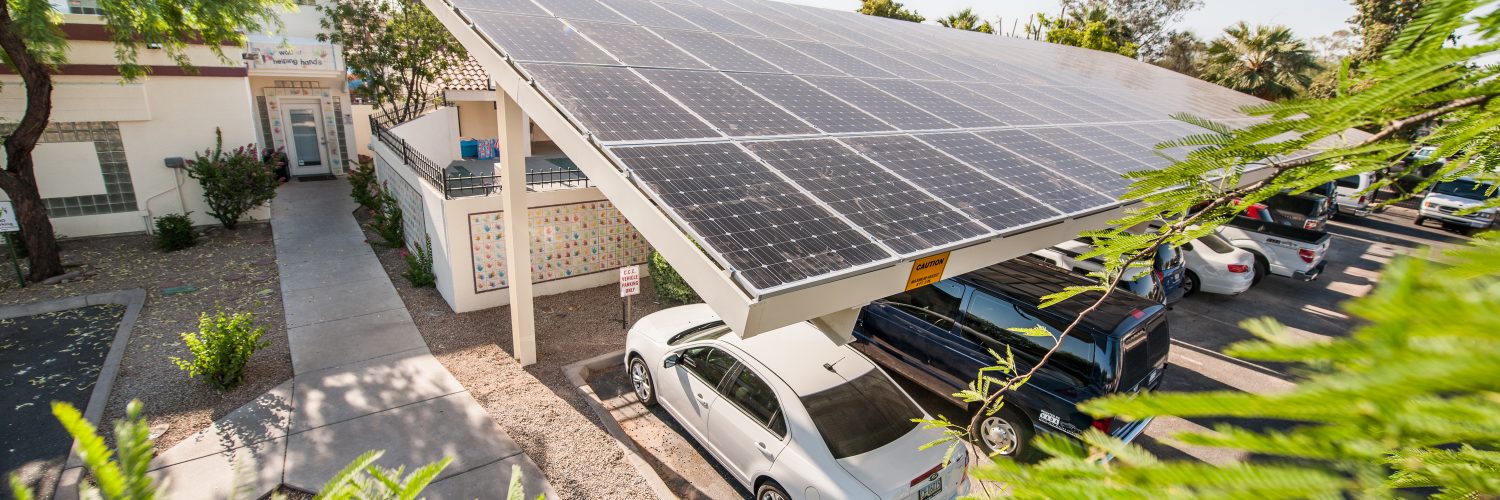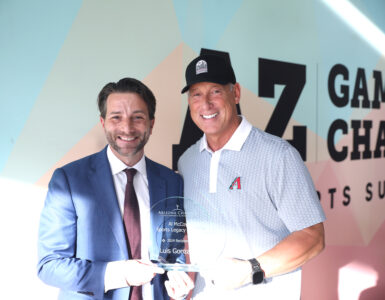Two of Arizona’s biggest power utilities have been giving back to the community’s most underserved members in the form of solar energy.
Arizona Public Service (APS) and Salt River Project (SRP) have each started programs to bring solar energy to the people — and charity organizations — who need it most.
As part of its Solar Communities program, APS donated enough solar panels to cover 144 spaces in the main parking lot for St. Vincent de Paul, a global nonprofit organization whose Phoenix chapter serves the Valley’s homeless population.
“The Solar Communities program enables limited- and moderate-income residential customers as well as non-residential customers such as Title 1 schools, rural governments and nonprofits to participate in clean energy while receiving a bill credit for their support,” said Tammy Kasprowicz, Solar Communities project manager at APS.
St. Vincent de Paul (SVdP) applied to be a part of the Solar Communities program and met all the requirements, she said.
“St. Vincent de Paul and many other incredible organizations benefiting our community will be further supporting their communities by helping to provide renewable, clean energy to the community around them while benefiting from a bill credit that they can then apply to the resources they currently offer,” Kasprowicz said.

Energy harvested by the new solar panel array — which generates enough power to run 86 homes per day — significantly reduces energy costs for the charity, sending savings back to programs that help people in need, according to SVdP.
“We are so thrilled and so grateful for this project,” said Steve Zabilski, executive director of SVdP in Phoenix. “This is literally a million-dollar project for APS, and with our focus on serving economically-challenged families, we could never have afforded such an investment.”
APS is Arizona’s largest public utility, with more than 1.4 gigawatts of solar energy available to customers today. APS predicts that renewable energy sources, including solar, will grow from 12 percent to 18 percent of the company’s overall energy mix over the next 15 years.
Salt River Project has also made serving the community a primary mission. The Tempe-based utility’s “Solar for Nonprofits” program helps charitable organizations reduce their energy costs by providing and installing solar panel systems.
“Nonprofits serve the communities and our customers, and SRP is committed to providing programs that help our communities thrive,” said Dan Dreiling, director of customer programs at SRP.
Since 2007, the program has completed 49 solar system installations, helping nonprofits save more than $600,000 collectively while providing green, emission-free energy for their buildings, according to SRP.
Earlier this month, the company announced it has donated solar systems to three Valley nonprofits: A New Leaf, which provides shelter and resources to homeless youth, domestic abuse victims and others who are struggling; Arizona Humane Society, a no-kill animal shelter that takes in abused and abandoned pets; and the Arizona Agribusiness and Equine Center (AAEC), an early college high school system that partners with community colleges that offers students the chance to earn college-transferable credits while completing high school classes.
“At SRP, we believe in giving back to the community, and we do that in a number of ways through contributions and employees who volunteer in the community,” Dreiling said.
AAEC Early College High School Principal Eric Stevens said he considered the solar panels to be a “great opportunity” for the school.
“Any money saved as a part of lowering our energy consumption will go into broadening and enhancing educational opportunities for our students,” he said.
SRP’s Solar for Nonprofits program is funded by SRP and its customers, who can opt-in to contribute as little as $3 a month.
“This is a great partnership with our customers who contribute to the program, and an impactful way to invest in green energy while helping nonprofit agencies direct more funds to the communities they serve,” Dreiling said. “The program supports our commitment to investing in Arizona-produced, solar energy projects that also benefit the nonprofit arena.”
According to the Arizona Humane Society, the savings from the solar installation at the organization’s Nina Mason Pullman Campus for Compassion could be used to help treat 530 orphaned, newborn kittens or 220 puppies and dogs in need of treatment for Parvovirus.
“The impact that the savings from the solar installation will have on hundreds of the Valley’s most vulnerable animals is truly lifesaving,” said Dr. Steven Hansen, president and CEO of the Arizona Humane Society. “These funds will ensure that the efforts taking place in critical medical areas such as AHS’ trauma hospital, Parvo Puppy ICU and newborn kitten nursery will go even further to save the lives of pets who are not often given a second chance in other shelters.”
A New Leaf CEO Michael Hughes said he was thrilled when he learned that SRP would be donating solar panels, calling the project “innovation with a heart.”
Dreiling said SRP plans to continue the Solar for Nonprofits program, promoting the cause to attract new customers who may be interested in participating.
As for APS, SVdP served as the inaugural nonprofit construction and installation site for the Solar Communities program, which will continue to partner with established Arizona nonprofits to provide solar-generating parking panels.
The project began in February 2019, coordinated by SVdP Senior Advisor Steve Gervais. The panels were fully installed, wired to the grid and generating solar energy by June.
“It was an honor for St. Vincent de Paul to be selected as the first site under the APS Solar Communities program for nonprofits in Arizona,” Gervais said. “By any standard, this was no small project.”
Kasprowicz said APS is committed to helping solar energy expand as a resource for Arizona.
“We are advancing Arizona’s solar leadership while providing safe, reliable and increasingly clean energy to our more than 1.2 million customers,” she said. “In addition to expanding access to solar for customers statewide, our Solar Communities program is helping to maintain solar jobs in Arizona, which benefits the state’s economy.”
















Add comment